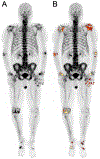Total-Body PET Imaging of Musculoskeletal Disorders
- PMID: 33218607
- PMCID: PMC7684980
- DOI: 10.1016/j.cpet.2020.09.012
Total-Body PET Imaging of Musculoskeletal Disorders
Abstract
Imaging of musculoskeletal disorders, including arthritis, infection, osteoporosis, sarcopenia, and malignancies, is often limited when using conventional modalities such as radiography, computed tomography (CT), and MR imaging. As a result of recent advances in Positron Emission Tomography (PET) instrumentation, total-body PET/CT offers a longer axial field-of-view, higher geometric sensitivity, and higher spatial resolution compared with standard PET systems. This article discusses the potential applications of total-body PET/CT imaging in the assessment of musculoskeletal disorders.
Keywords: Arthritis; Cancer; Fever of unknown origin; Osteoporosis; Osteosarcoma; PET/CT; PET/MR imaging; Sarcopenia.
Copyright © 2020 Elsevier Inc. All rights reserved.
Conflict of interest statement
Disclosure UC Davis has a revenue-sharing agreement with United Imaging Healthcare. The authors have no other matters to disclose. Conflict of interest The authors have declared no conflicts of interest.
Figures







References
-
- Briggs AM, Cross MJ, Hoy DG, et al. Musculoskeletal Health Conditions Represent a Global Threat to Healthy Aging: A Report for the 2015 World Health Organization World Report on Ageing and Health. Gerontologist. 2016;56 Suppl 2:S243–255. - PubMed
-
- Murray CJ, Barber RM, Foreman KJ, et al. Global, regional, and national disability-adjusted life years (DALYs) for 306 diseases and injuries and healthy life expectancy (HALE) for 188 countries, 1990–2013: quantifying the epidemiological transition. The Lancet. 2015;386(10009):2145–2191. - PMC - PubMed
-
- March L, Smith EU, Hoy DG, et al. Burden of disability due to musculoskeletal (MSK) disorders. Best Practice & Research: Clinical Rheumatology. 2014;28(3):353–366. - PubMed
-
- Gholamrezanezhad A, Guermazi A, Salavati A, Alavi A. Evolving Role of PET-Computed Tomography and PET-MR Imaging in Assessment of Musculoskeletal Disorders and Its Potential Revolutionary Impact on Day-to-Day Practice of Related Disciplines. PET Clin. 2018;13(4):xiii–xiv. - PubMed
Publication types
MeSH terms
Grants and funding
LinkOut - more resources
Full Text Sources
Other Literature Sources
Research Materials

